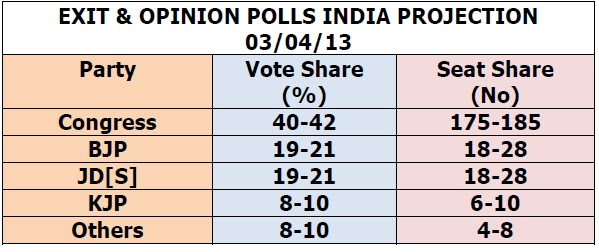In 2008, the winner BJP went neck-and-neck with the Congress in vote share and many seats were too close to call until the last round of counting. With Yeddyurappa and the Bellary group in the fray, the election this time may go down to the wires
A look at the pattern of vote shares of political parties in Karnataka shows that the ruling Bharatiya Janata Party (BJP) has consistently increased its base since 1994, gaining from both Congress and Janata Dal (Secular). Whether or not there would be reversals in this trend is something to keenly watch for in the ensuing Karnataka Assembly election on May 5.
In the 2008 elections, the BJP got a vote share of 33.86 per cent and won 110 seats, improving upon its earlier tally of 28.33 per cent votes and 79 seats. The Congress was marginally ahead of BJP in terms of vote share with 34.76 per cent — a decline from 35.27 per cent in 2004. JD(S) fell from 20.77 to18.96 per cent.
The story of BJP’s gain begins in 1994, when the party achieved a fourfold increase from 4.14 to 16.99 per cent vote share and a ten-fold increase in seats from 4 to 40 from the previous 1989 polls. This trend of ascendency could not be arrested by either the Congress or the JD in the next three elections, when it rose to 20.69 per cent (1999), 28.33 per cent (2004) and 33.86 (2008).
The converse of this is true of Congress, whose vote share plummeted to 26.95 per cent in 1994 from 43.76 in 1989. It got only 34 seats that year, the lowest ever in the State. This was attributed to the desertion of Lingayat votes due to the unceremonious ouster of Veerendra Patil from the post of the chief minister and formation of Karnataka Congress Party by former chief minister S. Bangarappa, besides anti-incumbency factors.
Even though the Congress pulled back from the brink in 1999 with 40.84 per cent votes, its vote share has declined consistently since then.
Though a major gainer in 1994 was Janata Dal (then undivided), the BJP too made significant gains. For the first time, it gained five seats in Bombay-Karnataka region in the north, a Lingayat stronghold and a bastion it has held and consolidated since then. Former chief minister B.S. Yeddyurappa played an important role in this process. The split of JD into two factions also saw more votes swinging to BJP post 1999 in the northern belt. The backing of big moneybags like mining baron Janardhan Reddy and his aides had no small role in the rise of the party. On the coastal belt, the nationwide Hindutva wave helped the party’s consolidation in 1994 which it strengthened in later years.
Interestingly, many of these factors are not in BJP’s favour in the run up to the 2013 polls. The newly formed Karnataka Janata Party of Mr. Yeddyurappa and Badavara Shramikara Raitara (BSR) Congress of B.S. Sriramulu, former minister and aide of Mr. Reddy, is expected to split votes in the northern and central districts. The Urban Local Body elections held in March showed that the BJP is not the force it was in 2004 even in the coastal districts of Dakshina Kannada and Udupi. Congress and JD(S) are expected to make gains riding on the anti-incumbency mood.
How these changing equations will get reflected in the voting percentages is as yet hard to predict, considering that no party seems sure-footed, even though polling day is less than a month away.
(Bageshree S.| Hindu)


